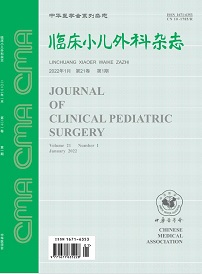Xu Lei,Zhang Yuchen,Zhou Dafei,et al.Analysis of factors influencing the navigated physeal bar resection for the treatment of ankle varus caused by traumatic premature physeal closure of the distal tibial physis in children[J].Journal of Clinical Pediatric Surgery,,():1009-1014.[doi:10.3760/cma.j.cn101785-202409048-002]
Analysis of factors influencing the navigated physeal bar resection for the treatment of ankle varus caused by traumatic premature physeal closure of the distal tibial physis in children
- Keywords:
- Physeal Bar Resection; Premature Physeal Closure; Ankle Varus; Growth Potential; Surgical Procedures; Operative; Child
- Abstract:
- Objective To analyze the clinical characteristics of navigated physeal bar resection (PBR) for ankle varus deformity caused by traumatic premature physeal closure of the distal tibial physis in children and to explore the factors influencing the success of the procedure. Methods A retrospective analysis was conducted on pediatric patients with traumatic premature physeal closure of the distal tibial physis resulting in ankle varus who underwent navigated PBR at the Department of Pediatric Orthopedics of Beijing Jishuitan Hospital,Capital Medical University,from June 2002 to October 2021.The clinical data analyzed included gender,age,injury mechanism,bone bridge morphology,time from injury to surgery,method of physeal blockage,osteotomy approach,deformity correction time,and measurement of the lateral distal tibial angle (LDTA).Based on imaging data,patients were divided into successful and failed PBR groups.Patients were also grouped by growth potential,with boys over 12 and girls over 10 classified as having low growth potential.A multivariate logistic regression analysis was performed to identify factors influencing the success of the PBR. Results A total of 63 children were included in the study,with an average age of 9.1 ±2.5 years at the time of surgery and a follow-up period of 32.0(22.0,54.0) months.The time from injury to PBR was 18.0(13.0,28.0) months.There were 47 patients in the high-growth-potential group (30 boys,17 girls) and 16 in the low-growth-potential group (9 boys,7 girls).All patients underwent navigated PBR,with 25 cases receiving concurrent lateral distal tibial physeal blockage and 11 cases undergoing concurrent osteotomy.The preoperative LDTA was 108.1±5.5° in the successful group and 112.7±6.2° in the failed group,showing a statistically significant difference (t=-3.129,P=0.003).Multivariate logistic regression analysis indicated that growth potential (OR=15.122,95%CI:2.076-110.159,P=0.007) and preoperative LDTA (OR=0.855,95%CI:0.755-0.969,P=0.014) were independent factors influencing the success of PBR. Conclusions PBR for ankle varus deformity caused by traumatic premature physeal closure of the distal tibial physis in children is challenging.Growth potential is a critical factor affecting surgical outcomes.Careful patient selection,including accurate assessment of physeal function and growth potential,proper surgical planning,precise navigation-guided procedures,and close postoperative follow-up are key to surgical success.
References:
[1] Su AW,Larson AN.Pediatric ankle fractures:concepts and treatment principles[J].Foot Ankle Clin,2015,20(4):705-719.DOI:10.1016/j.fcl.2015.07.004.
[2] Ecklund K,Jaramillo D.Imaging of growth disturbance in children[J].Radiol Clin North Am,2001,39(4):823-841.DOI:10.1016/s0033-8389(05)70313-4.
[3] Ecklund K,Jaramillo D.Patterns of premature physeal arrest:MR imaging of 111 children[J].AJR Am J Roentgenol,2002,178(4):967-972.DOI:10.2214/ajr.178.4.1780967.
[4] Peterson HA.Partial growth plate arrest and its treatment[J].J Pediatr Orthop,1984,4(2):246-258.DOI:10.1097/01241398-198403000-00015.
[5] Wuerz TH,Gurd DP.Pediatric physeal ankle fracture[J].J Am Acad Orthop Surg,2013,21(4):234-244.DOI:10.5435/JAAOS-21-04-234.
[6] Puno RM,Vaughan JJ,Stetten ML,et al.Long-term effects of tibial angular malunion on the knee and ankle joints[J].J Orthop Trauma,1991,5(3):247-254.DOI:10.1097/00005131-199109000-00001.
[7] Khoshhal KI,Kiefer GN.Physeal bridge resection[J].J Am Acad Orthop Surg,2005,13(1):47-58.DOI:10.5435/00124635-200501000-00007.
[8] Langenski?ld A.An operation for partial closure of an epiphysial plate in children,and its experimental basis[J].J Bone Joint Surg Br,1975,57(3):325-330.
[9] Kang HG,Yoon SJ,Kim JR.Resection of a physeal bar under computer-assisted guidance[J].J Bone Joint Surg Br,2010,92(10):1452-1455.DOI:10.1302/0301-620X.92B10.24587.
[10] Fu G,Wang W,Dong YF,et al.Treatment of post-traumatic pediatric ankle varus deformity with physeal bar resection and hemi-epiphysiodesis[J].Curr Med Sci,2019,39(4):604-608.DOI:10.1007/s11596-019-2080-9.
[11] Hasler CC,Foster BK.Secondary tethers after physeal bar resection:a common source of failure?[J].Clin Orthop Relat Res,2002,405:242-249.DOI:10.1097/00003086-200212000-00031.
[12] Leary JT,Handling M,Talerico M,et al.Physeal fractures of the distal tibia:predictive factors of premature physeal closure and growth arrest[J].J Pediatr Orthop,2009,29(4):356-361.DOI:10.1097/BPO.0b013e3181a6bfe8.
[13] Blondin E,Stourbe O,Plancq MC,et al.Outcomes of pediatric distal tibial physeal fractures[J].Orthop Traumatol Surg Res,2022,108(6):103199.DOI:10.1016/j.otsr.2022.103199.
[14] Westh RN,Menelaus MB.A simple calculation for the timing of epiphysial arrest:a further report[J].J Bone Joint Surg Br,1981,63-B (1):117-119.DOI:10.1302/0301-620X.63B1.7204464.
[15] Saint-Martin P,Rérolle C,Dedouit F,et al.Age estimation by magnetic resonance imaging of the distal tibial epiphysis and the calcaneum[J].Int J Legal Med,2013,127(5):1023-1030.DOI:10.1007/s00414-013-0844-5.
[16] 谢晓迪,王理昂,张鸿飞,等.骨骺闭合时间变化及其影响因素[J].临床医学进展,2021,11(5):2182-2188.DOI:10.12677/acm.2021.115313. Xie XD,Wang LA,Zhang HF,et al.Changes of epiphyseal closing time and its influencing factors[J].Adv Clin Med,2021,11(5):2182-2188.DOI:10.12677/acm.2021.115313.
[17] Beals RK,Skyhar M.Growth and development of the tibia,fibula,and ankle joint[J].Clin Orthop Relat Res,1984,182:289-292.
[18] Williamson RV,Staheli LT.Partial physeal growth arrest:treatment by bridge resection and fat interposition[J].J Pediatr Orthop,1990,10(6):769-776.
[19] Xiao H,Li M,Tan Q,et al.Physeal bar resection by modified arthroscopically assisted surgery in a closed osteocavity[J].Front Pediatr,2023,11:1157192.DOI:10.3389/fped.2023.1157192.
Memo
收稿日期:2024-9-19。
基金项目:北京积水潭医院院级科研基金“天玑骨科手术机器人临床应用研究”项目(GCZX202203)
通讯作者:鲁明,Email:lumingit@sina.com
